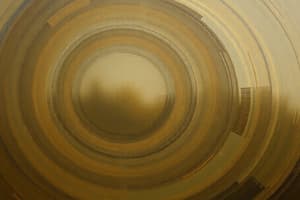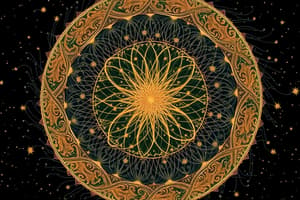Podcast
Questions and Answers
A projectile is launched at an angle of 30 degrees with an initial velocity of 20 m/s. Neglecting air resistance, what is the maximum height reached by the projectile?
A projectile is launched at an angle of 30 degrees with an initial velocity of 20 m/s. Neglecting air resistance, what is the maximum height reached by the projectile?
5.1 meters
An object is moving in a circle of radius 5 meters at a constant speed of 10 m/s. Calculate the centripetal acceleration of the object.
An object is moving in a circle of radius 5 meters at a constant speed of 10 m/s. Calculate the centripetal acceleration of the object.
20 m/s²
A satellite is orbiting Earth at a distance equal to twice Earth's radius. What is the gravitational potential energy of the satellite in terms of its mass $m$, Earth's mass $M$, and Earth's radius $R$?
A satellite is orbiting Earth at a distance equal to twice Earth's radius. What is the gravitational potential energy of the satellite in terms of its mass $m$, Earth's mass $M$, and Earth's radius $R$?
$-GmM/3R$
Briefly describe Young's double-slit experiment and how it demonstrates the wave nature of light.
Briefly describe Young's double-slit experiment and how it demonstrates the wave nature of light.
Outline Fizeau's method for measuring the speed of light, mentioning the key components and principles involved.
Outline Fizeau's method for measuring the speed of light, mentioning the key components and principles involved.
Describe the photoelectric effect and how it supports the quantum nature of light.
Describe the photoelectric effect and how it supports the quantum nature of light.
A ball is thrown horizontally from the top of a building with an initial speed of 15 m/s. If the building is 20 meters high, how far from the base of the building will the ball land?
A ball is thrown horizontally from the top of a building with an initial speed of 15 m/s. If the building is 20 meters high, how far from the base of the building will the ball land?
A car is traveling around a circular track with a radius of 100 meters. If the car's speed is increasing at a rate of 2 m/s², and its current speed is 15 m/s, what is the magnitude of the car's total acceleration?
A car is traveling around a circular track with a radius of 100 meters. If the car's speed is increasing at a rate of 2 m/s², and its current speed is 15 m/s, what is the magnitude of the car's total acceleration?
A rocket is launched from the Earth's surface. What minimum initial speed (escape velocity) must it have to escape the Earth's gravitational field, assuming no other forces act on it?
A rocket is launched from the Earth's surface. What minimum initial speed (escape velocity) must it have to escape the Earth's gravitational field, assuming no other forces act on it?
Explain how the results of the Michelson-Morley experiment influenced the understanding of the nature of light and the concept of a luminiferous ether.
Explain how the results of the Michelson-Morley experiment influenced the understanding of the nature of light and the concept of a luminiferous ether.
Describe Roemer's method for estimating the speed of light, highlighting its astronomical basis.
Describe Roemer's method for estimating the speed of light, highlighting its astronomical basis.
How does the Compton effect provide evidence for the particle-like nature of light?
How does the Compton effect provide evidence for the particle-like nature of light?
A projectile is fired upwards at an angle from a cliff. Describe how increasing the launch angle (while keeping initial speed constant) affects the range and maximum height of the projectile.
A projectile is fired upwards at an angle from a cliff. Describe how increasing the launch angle (while keeping initial speed constant) affects the range and maximum height of the projectile.
A car is moving around a banked curve. Explain how the banking angle and the car's speed affect the centripetal force required to keep the car on the track.
A car is moving around a banked curve. Explain how the banking angle and the car's speed affect the centripetal force required to keep the car on the track.
Explain how gravitational potential energy is converted to kinetic energy as an object falls freely towards Earth.
Explain how gravitational potential energy is converted to kinetic energy as an object falls freely towards Earth.
Describe how the wave nature of electrons is utilized in electron microscopy to achieve higher resolution compared to light microscopy.
Describe how the wave nature of electrons is utilized in electron microscopy to achieve higher resolution compared to light microscopy.
Outline the key differences between Newton's corpuscular theory of light and Huygens' wave theory of light.
Outline the key differences between Newton's corpuscular theory of light and Huygens' wave theory of light.
Explain how the concept of quantized energy levels, as proposed by Planck, helped resolve the ultraviolet catastrophe in blackbody radiation.
Explain how the concept of quantized energy levels, as proposed by Planck, helped resolve the ultraviolet catastrophe in blackbody radiation.
Two projectiles are launched with the same initial speed. One is launched at 40 degrees, the other at 50 degrees. Assuming level ground and no air resistance, which projectile will have the longer range, and which will reach a higher maximum height?
Two projectiles are launched with the same initial speed. One is launched at 40 degrees, the other at 50 degrees. Assuming level ground and no air resistance, which projectile will have the longer range, and which will reach a higher maximum height?
Explain how the equivalence principle connects gravity and acceleration, and give an example of how this principle can be observed.
Explain how the equivalence principle connects gravity and acceleration, and give an example of how this principle can be observed.
Flashcards
Projectile Motion Calculations
Projectile Motion Calculations
Projectile motion calculations involve analyzing the horizontal and vertical components of motion to determine range, maximum height, and time of flight, considering factors like initial velocity and launch angle.
Circular Motion Calculations
Circular Motion Calculations
Circular motion calculations involve analyzing the velocity, acceleration, and forces acting on an object moving in a circular path, including centripetal force and angular velocity.
Gravitational Field Calculations
Gravitational Field Calculations
Gravitational field calculations involve determining the gravitational force, potential energy, and motion of objects within gravitational fields, using Newton's law of gravitation and energy conservation principles.
Wave Nature of Light Experiments
Wave Nature of Light Experiments
Signup and view all the flashcards
Measuring the Speed of Light
Measuring the Speed of Light
Signup and view all the flashcards
Quantum Nature of Light Experiments
Quantum Nature of Light Experiments
Signup and view all the flashcards
Study Notes
- Topics covered include projectile motion, circular motion, energy in gravitational fields, the wave and quantum nature of light, and methods for measuring the speed of light.
Projectile Motion Calculations
- Projectile motion involves analyzing the trajectory of objects launched into the air, considering factors like initial velocity, launch angle, and gravity.
- Calculations often determine range, maximum height, and time of flight.
Circular Motion Calculations
- Circular motion describes the movement of an object along a circular path, characterized by constant speed but continuously changing direction.
- Calculations involve centripetal force, centripetal acceleration, period, and frequency.
Motion and Energy in Gravitational Fields
- Gravitational fields affect the motion and energy of objects, dictating their trajectories and potential energy.
- Calculations can determine escape velocity, orbital speed, and gravitational potential energy.
Historical Experiments: Wave Nature of Light
- Several historical experiments demonstrated light's wave nature, challenging earlier particle theories.
- Thomas Young's double-slit experiment showed interference patterns, a hallmark of wave behavior.
Historical Methods: Measuring the Speed of Light
- Historically, measuring the speed of light has been a challenge, leading to innovative experimental designs.
- Ole Rømer used observations of Jupiter's moons to estimate the speed of light in the 17th century.
- Armand Fizeau used a rotating toothed wheel and a distant mirror to measure the time it took for light to travel a known distance.
Historical Experiments: Quantum Nature of Light
- Early 20th-century experiments revealed the quantum nature of light, introducing the concept of photons.
- Max Planck's work on blackbody radiation and Albert Einstein's explanation of the photoelectric effect were pivotal.
- The photoelectric effect, where light causes electrons to be emitted from a metal, demonstrated light's particle-like properties, where the energy of the emitted electrons depends on the frequency of the light, not its intensity.
Studying That Suits You
Use AI to generate personalized quizzes and flashcards to suit your learning preferences.




